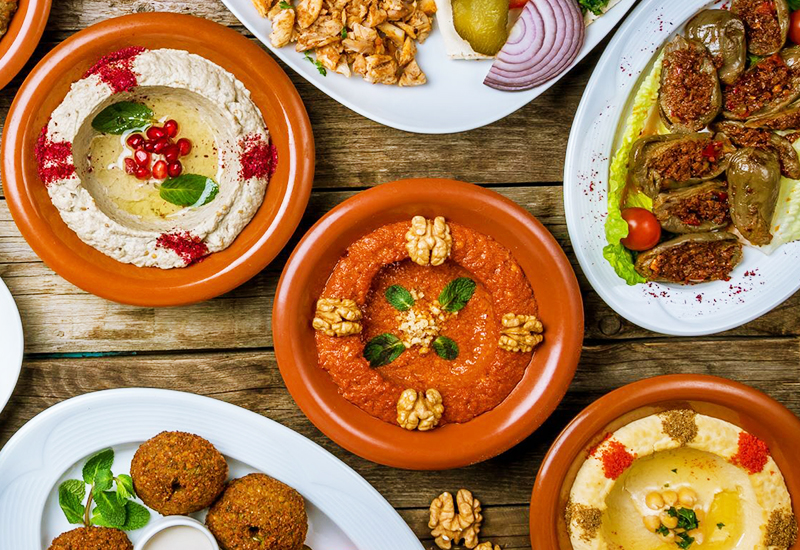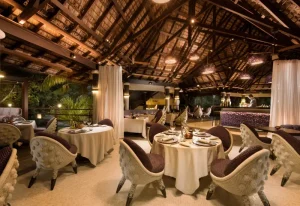Qatar, a vibrant and culturally diverse country in the Persian Gulf, boasts a rich culinary heritage that is as enticing as it is flavorful. Traditional Qatari Dishes are a testament to Qatar’s history, blending influences from Bedouin, Persian, Indian, and Levantine cultures. The result is a gastronomic experience that tantalizes the taste buds and captivates the senses. Qatar traditional food and drinks offer delightful flavors and textures.
Qatar’s traditional food recipes include meat, vegetables, and a wide mixture of fragrant spices. The local cuisine of Qatar is highly recommended to visitors and tourists alike.
Let’s know more about Qatar traditional food in Doha. Read about the best street foods in Qatar.
Table of Contents
ToggleQatar’s Traditional Food and Drinks
Traditional Qatari Dishes are well-known for their outstanding quality and appeal for several reasons. First, Qatar’s Traditional Food menu is a blend of flavors and preparation methods from many culinary traditions, and it is strongly ingrained in the history and culture of the nation. Because of this blending, a distinctive and varied culinary experience that honors Qatar’s ethnic past is produced.
The local cuisine of Qatar places a strong emphasis on using premium, fresh ingredients. Qatar benefits from an abundance of fresh fish due to its proximity to the sea; this seafood is a mainstay in many traditional meals.
To further enhance the flavors and fragrances of the food, carefully chosen fruits, vegetables, and aromatic spices that are sourced locally are also used in Qatar’s traditional food recipes.
Shawarma
Both natives and visitors to Qatar have a particular place in their hearts for Shawarma. This popular street cuisine has become very popular all around the country and provides a tasty and fulfilling meal.
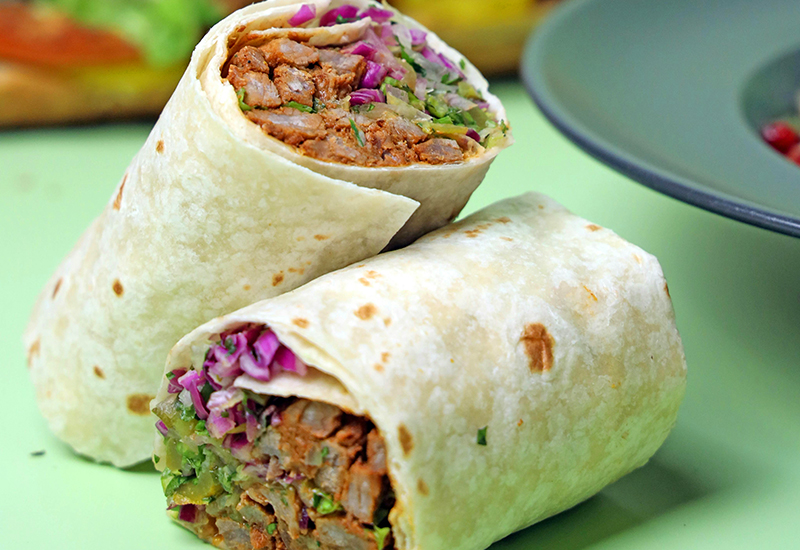
The Middle East is where Shawarma first appeared, and Qatar has welcomed this tasty cuisine with a local touch. The meticulous care to preparation is what distinguishes Shawarma from Qatar. Garlic, cumin, paprika, and other spices and herbs are marinated with the meat to give it a unique flavor that is savory and fragrant.
Thinly sliced, the delicately roasted meat is served in a toasted pita pocket or wrapped in warm, fluffy bread. Qatari Shawarma is not just a meal in the local cuisine of Qatar; it is an experience. It is commonly enjoyed as a quick street food snack or as a satisfying meal on the go.
Restaurants for eating Shawarma: Al Nafourah Garden, Arabesque Restaurant, Turkey Central
Madroba
A culinary treasure that highlights the diverse flavors and cultural legacy of Qatar is Madroba, a traditional dish from the country. Rice, meat (often chicken or lamb), and a special combination of aromatics and spices come together to make this filling and cozy dish.
The addition of broken and combined dried bread, called Rgaag, to Madroba, is what sets it apart. Madroba’s peculiar texture comes from this unusual ingredient, which also lends a faint crunch that contrasts wonderfully with the delicate meat and rice.
In addition to being a tasty meal, Madroba has cultural significance in Qatar. It is frequently served during celebratory events and family get-togethers, bringing people together to enjoy a special meal.
Madroba’s flavors bring back fond memories and feelings of coziness, making it a treasured component of Qatari cuisine.
Restaurants for eating Madroba: Damasca One Restaurant, Beirut Restaurant, Bayt El Talleh Restaurant
Majboos
A staple of Qatari cuisine, Majboos, often referred to as Kabsa, has a unique place in Qatar’s traditional food in Doha. A mainstay of Qatari cuisine, this fragrant and savory rice dish is frequently offered at celebrations and get-togethers.
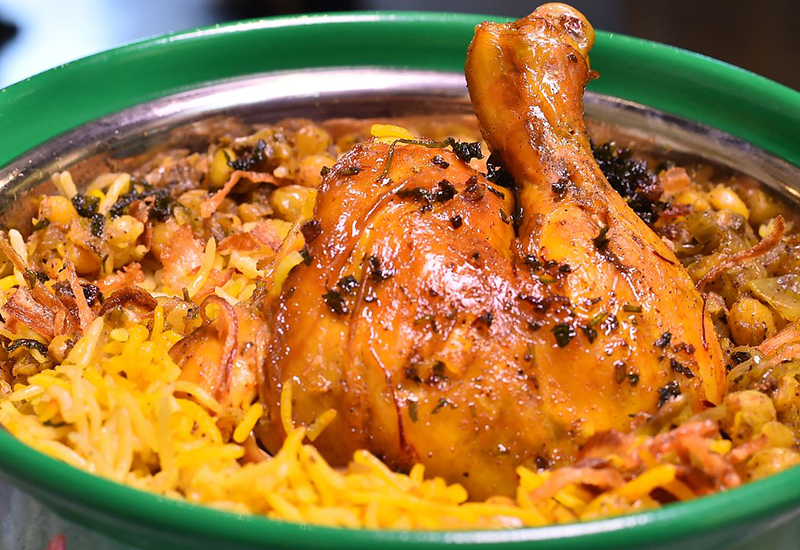
The perfume and flavor of mambos are mostly derived from a fragrant blend of spices, such as cardamom, cinnamon, cloves, and saffron. Meat, such as chicken, lamb, or fish, marinated in a spice mixture and cooked to exquisite perfection, is typically the main ingredient in mambos.
The dish is prepared by first sautéing onions, garlic, and spices to create an enticing basis of tastes.
Restaurants for eating Majboos: Majboos Al Walaida, SMAT Restaurant, Bayt Alwaldah Restaurant
Baleelat
A popular dish in Qatar for breakfast or as a sweet treat is called ballet. It’s a special blend of salty and sweet vermicelli noodles that creates a pleasant contrast in flavors.
The recipe calls for cooking vermicelli noodles until they are soft, at which point they are sautéed with a blend of spices, including saffron, cardamom, and cinnamon, which give the meal its unique flavor.
After that, the noodles are sweetened with honey or sugar, which gives the savory base a hint of sweetness. Fried onions, raisins, and occasionally crushed pistachios or almonds are used as garnishes with Balaleet, adding a nice crunch and taste.
It is usually served with scrambled eggs or an omelet on the side, combining the flavors of the dish pleasingly.
Restaurants for eating Baleelat: Bayt El Talleh Restaurant, Belhambar Qatari Restaurant, Twisted Olive & Naama’s Garden
Umm Ali
A delicious dessert with a specific significance in Qatari cuisine is umm ali. It is a classic bread pudding that is frequently consumed at holidays and get-togethers with family.
“Umm Ali” means “Mother of Ali,” and the dish has a long and illustrious history. According to legend, Umm Ali was established in Egypt under the Ayyubid Dynasty. This dish is claimed to have been made by Umm Ali to commemorate the passing of a notable ruler. Since then, it has gained popularity throughout the region, including Qatar.
Qatar’s traditional food recipes, such as Umm Ali, include layers of crispy puff pastry or phyllo dough layered in a baking dish to make Umm Ali. After that, the pastry is submerged in a luxurious concoction of sugar, milk, and cream that has been flavored with ground cinnamon, orange blossom water and rose water.

Raisins and nuts like almonds or pistachios are frequently added to foods to give them a wonderful crunch and texture.
Restaurants for eating Umm Ali: Atrium Lounge, Al Aker Sweets Souq Waqif, Yasmine Palace Doha Festival City
Luqaimat
A popular dessert in Qatar and the Middle East is Luqaimat. These little golden-fried dumplings are renowned for having a crispy outside and a soft, fluffy within. They are usually served extremely sweet, drenched in a copious amount of honey or date syrup.
The process of making Luqaimat entails mixing flour, yeast, sugar, and water into a basic batter. After that, the batter is allowed to ferment for a while so that the yeast may do its magic and give it a fluffy, light texture. Luqaimat is frequently savored at joyful festivals and important occasions, including Eid or Ramadan.
They can be offered as a tasty dessert on their own or in a bigger buffet with other traditional sweets from Qatar.
Restaurants for eating Luqaimat: Karaki cafe, Bayt El Talleh Restaurant, Fenjal Ashgar
Margoog
A beloved traditional dish in Qatar, margoog is known for its substantial and soothing features. It is a kind of stew where a variety of vegetables and flavorful spices are combined with meat, usually lamb or chicken.
A special component of margoog is frequently “margoog bread,” also known as “Raqeeq,” a flatbread that is broken up and mixed into the stew. As the bread absorbs the savory broth, the dish gains body and texture. Margoog is a filling and nutritious option because it has healthy veggies, fragrant spices, and tender beef.
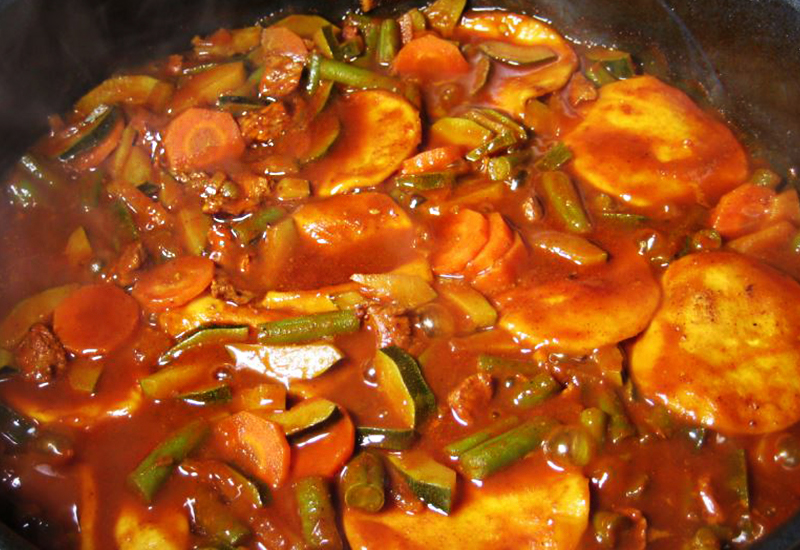
This dish highlights the tastes and customs of the area while providing a taste of Qatari culinary heritage. Margoog is a great choice to think about whether you’re trying out the regional food in Qatar or trying to make a traditional dish at home.
Restaurants for eating Margoog: Damasca One Restaurant, Al Khaima Restaurant, Bayt El Talleh Restaurant
Harees
The wheat and beef mixture was traditionally simmered for many hours over low heat in a big pot to achieve a thick and creamy consistency before serving Harees. On the other hand, time- and convenience-saving techniques in modern cooking, like pressure cookers and slow cookers, have improved the preparation procedure.
A traditional dish from Qatar, Harees (also called Jareesh or Jareeshah), is typically eaten during special occasions like the holy month of Ramadan. Made with wheat and meat, usually lamb or chicken, it’s a filling and healthy dish.
In addition to being a popular dish in Qatar, Haraees is also made with somewhat different ingredients and cooking techniques in other Persian Gulf nations.
Restaurants for eating Harees: Harees Al Waldah, Hareesna Restaurant, Bayt Sharq
Warak Enab
Stuffed vine leaves, or Warak Enab, are a common dish in Qatari cuisine. It is significant since it is a national favorite and traditional delicacy. The meal is made out of rice, herbs, and occasionally minced meat that has been wrapped into vine leaves.
After cooking, it can be served as a main meal or an appetizer. Care and precision are needed in the preparation of Warak Enab. Carefully choose and blanch the vine leaves before stuffing them with the rice and herb mixture.
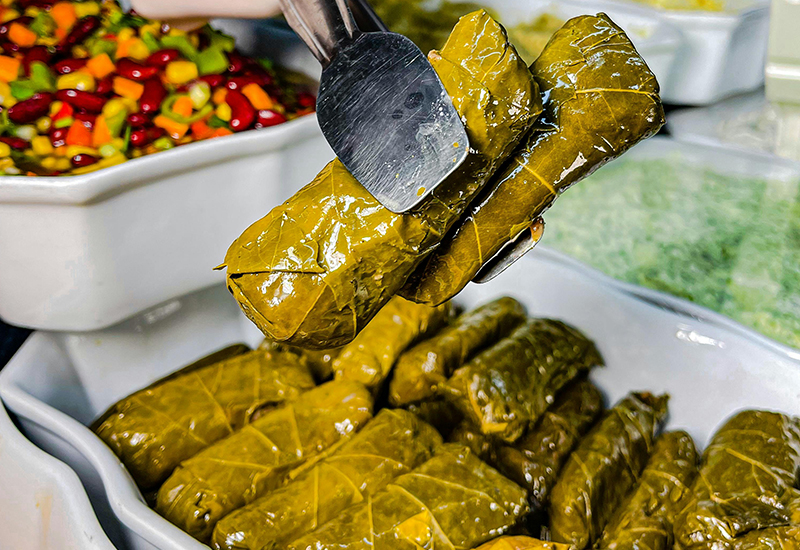
The stuffing’s unique flavor profile is enhanced by the addition of several spices, including mint, cinnamon, and allspice. Yogurt or a tart sauce made with tomatoes and lemon juice is frequently served with Warak Enab.
You can try this tasty food at the street food stalls in Qatar. Read about the best street foods in Qatar.
Restaurants for eating Warak Enab: Shisha Garden, Yasmine Palace Restaurant, Arabesque Restaurant
Thareed
The traditional Qatari meal Tahareed is derived from Bedouin cooking. It’s a tasty, filling stew-type dish made up of layers of bread, veggies, and meat—usually chicken or lamb.
In addition to being offered throughout the holy month of Ramadan, Tahareed is also frequently enjoyed during special events and get-togethers. Traditionally served hot, thareed is best savored in a family-style gathering around a big communal pot.
Though Thareed typically uses pita or flatbread, there are regional versions that employ other kinds of bread. For instance, “rugag” is a traditional bread that is occasionally used in Qatar. Rugag is a crispy, thin bread that gives the meal a distinct texture.
Restaurants for eating Thareed: Harees Al Waldah, Harees Al Khaleej Restaurant
Samboosa
Samboosa, sometimes referred to as samosa, is a common Middle Eastern snack in Qatar. It is a pastry that is shaped like a triangle or cone and is filled with a savory variety of ingredients, including onions, potatoes, and minced beef or chicken, along with different herbs and spices.
In Qatar, people often eat Sambosas as an appetizer or snack. They are served hot and frequently come with a dipping sauce, including a hot yogurt-based sauce or a tart tamarind chutney.
Samboosas are a famous street food item among Traditional Qatari Dishes and are also popular during Ramadan and other festival occasions.
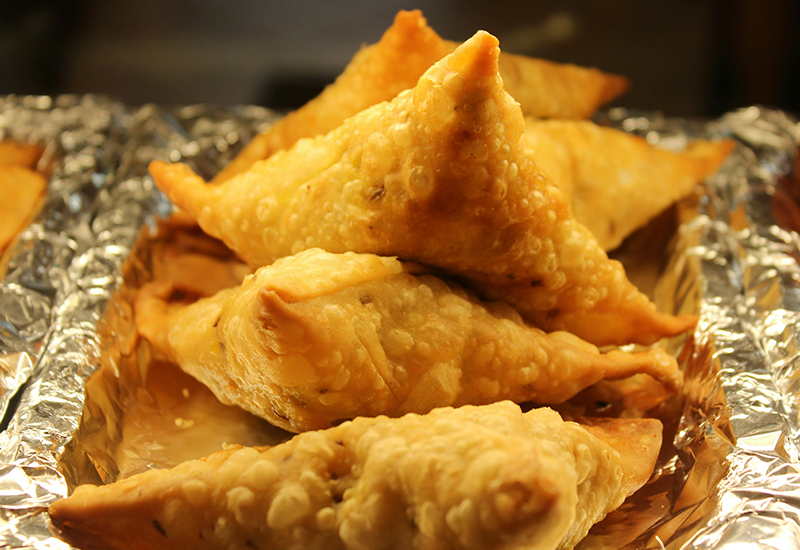
Samboosas are served in a variety of places in Qatar, such as eateries, cafeterias, and neighborhood bakeries. They are widely accessible and frequently offered as meals or as grab-and-go snacks.
Restaurants for eating Samboosa: Delhi Bakery, Chaska Restaurant Ezdan Oasis, Bombay Chowpatty
Karak
Karak is a potent traditional beverage in Qatar that is also referred to as Qahwa Karak or Qatari Karak. It has become incredibly popular among Qatar’s traditional food and drinks and is consumed all around the nation.
Usually brewed with black tea, milk, sugar, and a mixture of fragrant spices, karak is a powerful, spicy tea. To prepare Karak, black tea leaves are boiled in water with a variety of spices, including cardamom, saffron, and occasionally cinnamon.
The flavors are then infused into the tea by simmering it for a bit. Then, milk is added to give the texture a rich, creamy texture. Lastly, sugar is added to the tea according to personal taste preferences.
The popularity of Karak extends beyond Qatar, as it has become a symbol of Qatari culture and is recognized internationally.
It is not uncommon to find Karak being served in various cafes, restaurants, and street-side stalls across the country.
Restaurants for eating Samboosa: Chapati & Karak Cafe, Poori & Karak, New Plaza Cafeteria
Kousa Mahshi
Kousa Mahshi is Qatar’s traditional food vegetarian dish that is widely enjoyed in Qatar cuisine. It is a flavorful and hearty dish made with stuffed zucchini.
The name “Kousa Mahshi” translates to “stuffed zucchini” in English. To prepare Kousa Mahshi, small zucchinis are hollowed out and filled with a delicious mixture of rice, ground meat (usually lamb or beef), onions, herbs, and spices.
The stuffing is seasoned with a blend of spices like cinnamon, allspice, and nutmeg. Once the zucchinis are stuffed, they are cooked in a flavorful tomato-based sauce.
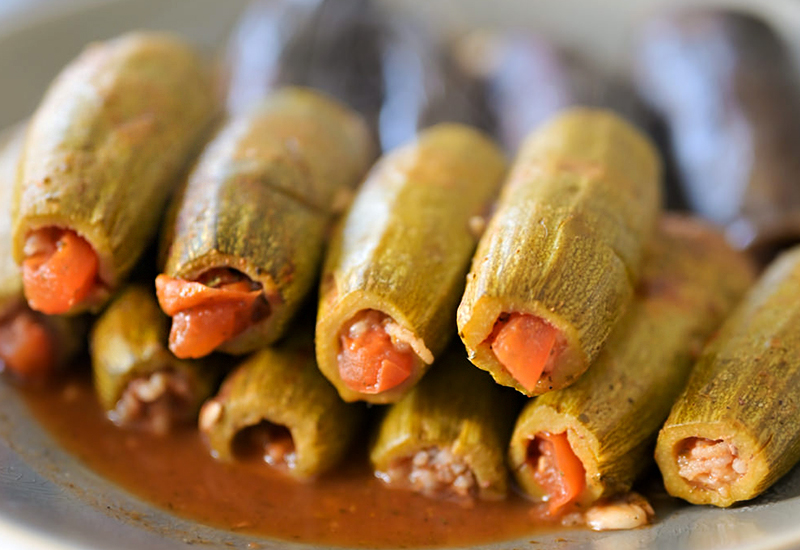
The sauce is made with tomatoes, garlic, onions, and sometimes a touch of lemon juice for added tanginess. The stuffed zucchinis are gently simmered in the sauce until they become tender, and the flavors meld together.
Restaurant for eating Kousa Mahshi: Al Shami Home Restaurant
Final Words
Enticing and savory, Qatar’s rich culinary legacy is a testament to its lively and culturally varied nation on the Persian Gulf. With its fusion of Bedouin, Persian, Indian, and Levantine elements, Qatari traditional food serves as a tribute to the country’s past.
Meat, vegetables, and a variety of aromatic spices are staples of traditional Qatari cuisine. Discovering Qatar’s traditional food is a pleasant culinary adventure that honors the nation’s legacy and tantalizes the palates of both locals and tourists. Savor a robust Machbous, indulge in a sweet Umm Ali, or enjoy tender Majboos at some of the best restaurants in Qatar.
Are you planning to travel to Qatar and looking for a Qatar travel agency? Check out our Qatar tours, and Qatar transit tours.

